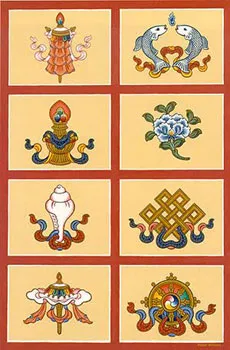
or (Ashtamangala) is a revered set of Eight Auspicious Signs found in Hinduism, Jainism, Buddhism, and Sikhism, among other Dharmic Traditions. Yidam and teaching tools are the symbols or’symbolic qualities.’ These traits, these energetic signatures, not only signpost to enlightened mindstream qualities, but they are also the adornment that adorns these enlightened ‘qualities.’ There are numerous cultural enumerations and variations of the Ashtamangala. Originally, groups of eight auspicious symbols were utilized in India at events such as a king’s inauguration or coronation. The throne, swastika, handprint, hooked knot, vase of jewels, water libation flask, pair of fishes, and lidded bowl were among the early symbols. These eight emblems of good fortune in Buddhism reflect the gods’ presents to Shakyamuni Buddha shortly after he attained enlightenment.
The umbrella or parasol (chhatra) represents riches or monarchy, as one must be wealthy enough to own one, and even more so to have someone hold it. It alludes to the “royal ease” and strength that can be found in the Buddhist detachment life.
Originally, the two fishes represented India’s two most sacred rivers, the Ganges and the Yamuna. The lunar and solar channels, which originate in the nostrils and convey the alternating rhythms of breath or prana, are linked to these rivers. They are sacred in Hindu, Jain, and Buddhist faiths, as well as in Christianity (the sign of the fish, the feeding of the five thousand). Fish signify happiness in Buddhism because they have complete freedom of movement in the water. They are thought to symbolize fertility and abundance. Often depicted in the form of carp, which are revered in the East for their graceful beauty, size, and longevity.
Health, life, wealth, success, wisdom, and the phenomenon of space are all represented by the treasure vase or Urn of Wisdom.
The lotus flower, hovering above the murky rivers of attachment and desire and signifying ‘primordial purity’ of the body, speech, and mind, depicts the complete blooming of wholesome deeds in blissful emancipation.
Conch – A right-turning white conch shell that represents the Buddhadharma’s beautiful, profound, melodious, interpenetrating, and ubiquitous sound, which awakens students from their deep slumber of ignorance and motivates them to pursue their own and others’ wellbeing.
The Knot — Also known as the ‘endless knot’ or ‘everlasting knot,’ the knot symbolizes the intertwining of wisdom and compassion, as well as the mutual reliance of religious teaching and secular matters.
Dhvaja Banner – The Dhvaja Banner was an ancient Indian military standard. Makara Dhvaja has since become an emblem of Kamadeva, the Vedic god of love and desire. A list of eleven different types of the victory banner is offered in Tibetan tradition to signify eleven specific strategies for overcoming defilements. On the roofs of Tibetan monasteries, many variations of the Dhvaja design may be seen to represent the Buddha’s victory over four maras.
The Dharma-Wheel (Dharmachakra) — The Wheel of Law, which can be used to represent Sakyamuni Buddha and the Dharma teaching, as well as the mandala and chakra. Tibetan Buddhists frequently utilize this emblem, which occasionally contains the Gankyil’s inner wheel (Tibetan).
